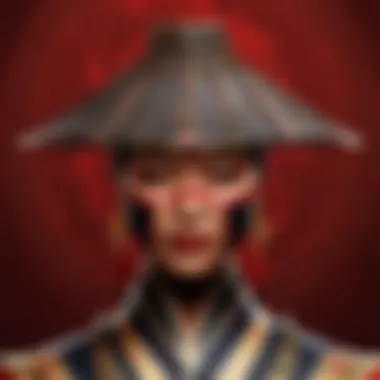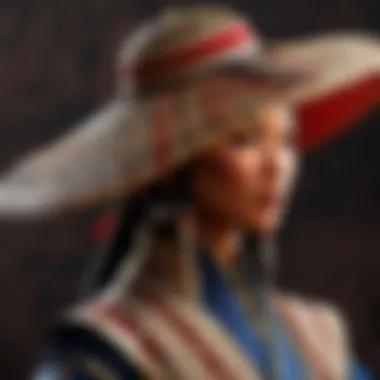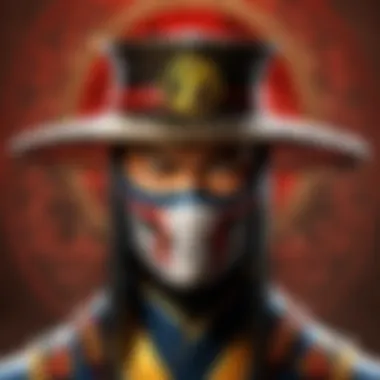Unveiling the Enchanting Universe of Asian Headwear: A Cultural Odyssey


Character Profiles & Movesets
Asian hats come in a rich variety of styles, each with its historical significance and unique design elements. From the elegant conical hats of Vietnam to the intricate turbans worn in India, these headpieces reflect the diverse cultural tapestry of Asia. Exploring the traditional craftsmanship and materials used in making these hats provides valuable insights into the artistic traditions passed down through generations. Understanding the symbolism behind different hat styles allows for a deeper appreciation of the cultural heritage they represent.
Gameplay Strategies & Tactics
When it comes to incorporating Asian hats into modern fashion trends, designers often fuse traditional elements with contemporary styles to create striking and innovative accessories. By experimenting with different fabrics, shapes, and embellishments, fashion houses can reinterpret classic hat designs in fresh and exciting ways. Understanding the historical context of each hat style enables designers to pay homage to traditional craftsmanship while incorporating a modern aesthetic. By studying the proportions and structure of traditional Asian hats, fashion enthusiasts can gain inspiration for creating avant-garde headwear that pays tribute to the rich heritage of Asian headgear.
Storyline & Lore Explorations
Delving into the historical evolution of Asian hats reveals fascinating insights into the social hierarchy and cultural norms of past eras. The symbolism attached to specific hat styles often reflects a person's status, occupation, or religious affiliation, providing a window into the societal values of bygone times. Moreover, the migration of hat styles across regions illustrates the interconnectedness of Asian cultures and their shared history. By tracing the evolution of hat styles over centuries, one can appreciate the dynamic nature of fashion trends and the enduring appeal of traditional headgear in contemporary society.
Updates & Patch Notes
In the realm of fashion, trends are constantly evolving, with designers drawing inspiration from a diverse range of sources, including Asian hat styles. Keeping abreast of the latest updates in the fashion world allows enthusiasts to stay ahead of the curve and experiment with incorporating Asian-inspired hats into their wardrobe. By monitoring fashion shows, trend forecasts, and designer collections, individuals can identify emerging hat styles influenced by Asian heritage and adapt them to their personal style. Embracing the fusion of traditional and modern sensibilities in fashion enables individuals to express their creativity while honoring the legacy of Asian hat craftsmanship.
Introduction to Asian Hats
Asian hats hold a fascinating cultural significance that spans centuries, offering insights into the historical, social, and fashion aspects of different societies. This article serves as a comprehensive guide to exploring the diverse styles and rich heritage associated with Asian headgear. From traditional conical hats to modern adaptations, the evolution of Asian hats reflects the changing trends and global influences in the fashion world.
Historical Origins
Ancient roots of Asian headwear
Asian hats have deep-rooted historical origins, tracing back to ancient civilizations. The significance of these headwear pieces lies in their connection to the traditional attire and practices of diverse Asian cultures. The ancient roots of Asian headwear highlight the craftsmanship and attention to detail that were prevalent in creating these iconic pieces. Despite their age-old history, these hats continue to be a symbol of cultural pride and heritage, standing the test of time with their enduring charm.
Cultural significance over centuries
The cultural significance of Asian hats has evolved over centuries, reflecting the changing landscapes of societies and their values. These headwear pieces were not merely fashion accessories but symbols of identity, status, and tradition. The enduring cultural significance over centuries showcases the resilience and adaptability of Asian hat styles, bridging the gap between past traditions and modern interpretations. Understanding this cultural legacy is crucial in appreciating the depth and diversity of Asian headwear.
Evolution of Styles
Traditional vs. contemporary designs
The evolution of Asian hat styles encompasses a blend of traditional aesthetics with modern influences. Contrasting the timeless appeal of traditional designs with the innovative flair of contemporary interpretations, Asian hats strike a balance between heritage and innovation. The interplay between traditional and contemporary designs adds a dynamic touch to the sartorial landscape, where old meets new in a harmonious fusion of style and culture.
Influence of fashion and globalization


Fashion trends and globalization have played a significant role in reshaping the perception of Asian hats on a global scale. The fusion of Asian hat styles with Western fashion sensibilities has led to a cross-cultural exchange of ideas and aesthetics. The influence of fashion and globalization has not only expanded the reach of Asian hats but has also spurred conversations on cultural appreciation and appropriation. Navigating this complex terrain requires a nuanced understanding of the interconnectedness of fashion, culture, and identity.
Materials and Construction
Silk, straw, bamboo, and more
Asian hats are crafted from a diverse range of materials, each possessing unique qualities that contribute to the overall design and function of the headwear. From the exquisite sheen of silk to the rustic charm of straw and bamboo, the choice of materials reflects the cultural heritage and environmental adaptability of Asian hat craftsmanship. Exploring the various materials used in crafting Asian hats offers insights into the meticulous attention to detail and artisanal skills required to produce these timeless pieces.
Craftsmanship and artisanal techniques
The craftsmanship and artisanal techniques employed in making Asian hats exemplify the dedication and creativity of skilled artisans. Each hat is crafted with precision and care, utilizing age-old techniques passed down through generations. The intricate weaving, intricate embroidery, and delicate embellishments showcase the meticulous craftsmanship that defines Asian hat-making traditions. Embracing these artisanal techniques not only preserves cultural heritage but also honors the legacy of craftsmanship that continues to inspire contemporary interpretations of Asian hats.
Popular Types of Asian Hats
When delving into the fascinating world of Asian hats, understanding the various popular types becomes crucial. These hats serve as significant cultural symbols and fashion statements within Asian societies. By exploring the nuances of popular Asian hats, one can grasp the depth of historical and social contexts intertwined with these distinctive headpieces. Whether it's the traditional conical hat, the unique Mokorotlo, the stylish Kasa, or the symbolic turban, each type offers a glimpse into the diverse and rich heritage of Asian headwear.
Conical Hat
The conical hat stands out as an iconic symbol of Asian agriculture, reflecting centuries-old traditions and craftsmanship. Its simplistic yet practical design has made it a staple in various Asian cultures. The conical hat's wide brim provides ample shade and protection from the sun, making it a preferred choice for farmers and laborers working in the fields. However, its versatility extends beyond function, with many considering it a timeless fashion accessory that embodies elegance and heritage.
Iconic symbol of Asian agriculture
The conical hat's association with agriculture runs deep, symbolizing the connection between humanity and nature. Its conical shape helps in efficient water runoff during rain and shields the wearer from intense sunlight. This hat's functionality and durability make it a practical and revered choice for those tending to the land, symbolizing resilience and adaptability in traditional Asian farming communities.
Variations across different regions
Across various Asian regions, the conical hat undergoes unique stylistic variations, reflecting local customs and preferences. From the intricately woven palm leaves of Southeast Asia to the bamboo weaves in East Asia, each region adds its flair to the conical hat's design. These regional variations not only showcase the diverse creativity in craftsmanship but also signify the unity in agricultural practices throughout Asia, celebrating shared heritage among farming communities.
Mokorotlo
The Mokorotlo, a traditional hat from Lesotho, serves as more than just headwear; it embodies the cultural identity of the Basotho people. Its distinct conical shape, often adorned with intricate designs and patterns, symbolizes pride in heritage and craftsmanship. Donned during special occasions and ceremonies, the Mokorotlo stands as a testament to the Basotho culture's resilience and rich traditions.
Lesotho's traditional hat
Hailing from Lesotho, the Mokorotlo holds a special place in Basotho culture, signifying dignity and respect for ancestral customs. Its shape is carefully crafted to represent the surrounding mountains, highlighting the Basotho's deep connection to their environment. Wearing the Mokorotlo is not merely a fashion choice but a significant cultural statement, showcasing a sense of belonging and loyalty to one's roots.
Symbol of Basotho culture


Beyond being a piece of attire, the Mokorotlo serves as a symbol of unity and cultural pride among the Basotho people. Passed down through generations, it carries the weight of history and community solidarity. The intricate patterns on the Mokorotlo depict narratives of Basotho traditions and values, exemplifying the essence of cultural storytelling through craftsmanship and style.
Kasa
The Kasa, a distinct Japanese umbrella hat, seamlessly combines functionality with fashion, representing a harmonious blend of practicality and style. Originating from Japan's rich tradition of craftsmanship, the Kasa serves as a protective headgear against sun and rain while exuding elegance and sophistication. Its unique design has garnered attention not just for its usability but also for its artistic appeal in the realm of Asian headwear.
Japanese umbrella hat
The Japanese umbrella hat, or Kasa, is a fine example of form meeting function in traditional Japanese attire. Its intricate construction from light, durable materials ensures both protection and comfort for the wearer. The Kasa's versatility lies in its ability to transform from a compact umbrella to a stylish hat, showcasing the Japanese ingenuity in wearable accessories that cater to practical needs without compromising on aesthetics.
Blend of functionality and style
What sets the Kasa apart is its seamless blend of functionality and style, catering to both practical and visual aspects of headwear. From shielding against the rain to making a fashion statement on sunny days, the Kasa exemplifies the Japanese approach to blending utility with elegance. This hat not only serves a useful purpose but also reflects the wearer's appreciation for traditional craftsmanship and cultural heritage.
Turban
In South Asia, the turban holds immense cultural significance, signifying dignity, honor, and social standing within the community. Its versatile nature allows it to be styled in various ways, representing different regions and traditions. Beyond being a fashion accessory, the turban serves as a symbolic headwear that reflects the wearer's identity, values, and history.
Cultural significance in South Asia
The turban's cultural significance in South Asia extends beyond mere fashion statements; it symbolizes respect for tradition and religious beliefs. Worn on special occasions and ceremonies, the turban signifies a man's transition to adulthood, marriage, or leadership roles. Its colors and style variations convey different messages, reflecting societal roles, ethnic backgrounds, and personal affiliations within South Asian communities.
Versatile and symbolic headwear
What makes the turban stand out is its versatility as both a practical head covering and a symbolic accessory. From the elaborate turbans worn by Sikh warriors to the intricately draped styles in Rajput culture, each turban tells a tale of heritage and pride. This headwear not only serves as a form of self-expression and cultural identity but also fosters a sense of belonging and unity among diverse communities in South Asia.
Fashion Trends and Global Influence
Fashion trends and global influence in the exploration of Asian hats are crucial for understanding the dynamic interplay between culture, tradition, and contemporary style. Asian hats, ranging from traditional conical hats to modern adaptations, serve as more than just mere fashion statements. They serve as cultural symbols and markers of heritage, bridging the past with the present. Understanding the evolution of Asian hats in the fashion world sheds light on how these accessories have transcended geographical boundaries to become iconic pieces that shape global trends and foster cultural exchange.
Asian Hats in Modern Fashion
Runway adaptations of traditional hats
Runway adaptations of traditional Asian hats represent a harmonious blend of heritage and innovation. Designers across the globe draw inspiration from traditional Asian headwear, reimagining shapes, colors, and materials to create runway pieces that capture the essence of cultural diversity. These adaptations not only pay homage to centuries-old craftsmanship but also propel Asian hats into the spotlight of high fashion, adding a touch of elegance and exoticism to contemporary collections. By showcasing traditional hats on runways, designers celebrate the artistry and cultural significance behind each piece, sparking a renewed appreciation for heritage accessories in a modern context.
Celebrity endorsements and pop culture impact


Celebrity endorsements play a pivotal role in popularizing Asian hats and incorporating them into mainstream fashion culture. When influential figures don Asian headwear, whether on red carpets or social media, they elevate these pieces from traditional artifacts to must-have fashion items. Their endorsement serves as a bridge between different cultures, promoting cross-cultural exchange and fostering appreciation for Asian sartorial traditions on a global scale. Furthermore, the pop culture impact of celebrities wearing Asian hats extends beyond mere trend-setting; it serves as a testament to the enduring allure and universality of these accessories, transcending borders and resonating with fashion enthusiasts worldwide.
Cultural Appreciation vs. Appropriation
Debates on respecting cultural origins
Debates surrounding the appropriation of Asian hats in mainstream fashion underscore the importance of respecting cultural origins and acknowledging the significance of these garments. While cultural appreciation involves recognizing and honoring the heritage behind Asian headwear, appropriation occurs when these symbols are divorced from their cultural context and commodified for trendy purposes. By delving into these debates, we navigate the complex terrain of cultural representation, emphasizing the need for sensitivity and awareness when incorporating elements of Asian culture into fashion discourse.
Issues of misrepresentation and stereotyping
Addressing issues of misrepresentation and stereotyping is imperative in ensuring that Asian hats are portrayed authentically and respectfully in the media and fashion industries. Misconceptions and stereotypes surrounding Asian headwear not only perpetuate cultural ignorance but also marginalize communities whose traditions are being inaccurately portrayed. By unpacking these issues, we confront the underlying biases and assumptions that contribute to the misrepresentation of Asian hats, advocating for a more inclusive and informed approach to showcasing cultural attire.
Influence on Western Fashion
Integration of Asian hat styles in Western trends
The integration of Asian hat styles into Western fashion trends marks a paradigm shift in the industry, symbolizing a newfound appreciation for global diversity and craftsmanship. Western designers are increasingly drawing inspiration from Asian aesthetics, infusing their collections with elements of Asian headwear to create a fusion of styles that transcends cultural boundaries. This integration not only enriches Western fashion by introducing fresh perspectives and designs but also promotes cross-cultural dialogue and mutual exchange, fostering a more inclusive and eclectic sartorial landscape.
Cross-cultural exchange and fusion
Cross-cultural exchange and fusion in the realm of fashion exemplify the transformative power of integrating diverse influences to create sartorial masterpieces that transcend conventional norms. By blending Asian hat styles with Western sensibilities, designers embark on a creative journey that celebrates cultural pluralism and challenges traditional notions of fashion. This exchange not only cultivates a deeper appreciation for global craftsmanship but also paves the way for new interpretations of tradition, as seen in the innovative fusion of Asian and Western aesthetics on international runways.
Conclusion: Embracing Diversity and Tradition
In this concluding section of the exploration into the fascinating world of Asian hats, it is imperative to underscore the significance of embracing diversity and tradition. The intricate tapestry of Asian hat culture is not merely a collection of headwear but a representation of centuries-old traditions and values. By delving into the plethora of Asian hat styles, we are not just admiring fashion; we are acknowledging the deep-rooted heritage and social nuances embedded in each hat's design. Embracing diversity and tradition in Asian headwear is a testament to our respect for different cultures and our appreciation for the stories these hats carry across generations.
Preserving Cultural Heritage
The importance of honoring traditions
When discussing the importance of honoring traditions within the realm of Asian hats, it becomes evident that these headpieces serve as more than just fashion statements. The essence of tradition lies in the meticulous craftsmanship and symbolism infused into each hat, reflecting the cultural ethos of diverse Asian societies. By honoring these traditions, we not only preserve history but also pay homage to the artisans who have dedicated their lives to perfecting this craft. This act of reverence towards tradition helps maintain a connection to our roots, fostering a sense of cultural pride and solidarity.
Sustainability and ethical considerations
The discourse on sustainability and ethical considerations in relation to Asian hats sheds light on the need for conscious consumption and responsible production practices. In a world increasingly dominated by fast fashion and environmental concerns, the preservation of traditional hat-making techniques and the promotion of ethical sourcing become paramount. By prioritizing sustainability, we ensure that future generations can continue to appreciate and learn from these cultural treasures without causing harm to the environment or compromising the welfare of artisans.
Celebrating Cultural Diversity
Promoting unity through shared experiences
One of the most compelling aspects of celebrating cultural diversity through Asian hats is the ability to promote unity through shared experiences. Regardless of our backgrounds or beliefs, we can all find common ground in our appreciation for the artistry and history encapsulated in these headpieces. By recognizing and celebrating the diverse range of Asian hat styles, we foster a sense of community and mutual respect, transcending boundaries and deepening our understanding of different cultures.
Embracing the beauty of cultural attire
In embracing the beauty of cultural attire, we acknowledge the intrinsic value of Asian hats beyond their aesthetic appeal. Each hat tells a story, weaving together threads of tradition, innovation, and identity. By embracing this beauty, we invite others to engage with us in a dialogue of cultural exchange, where learning and appreciating the uniqueness of each hat becomes a bridge to greater cultural understanding and harmony.







